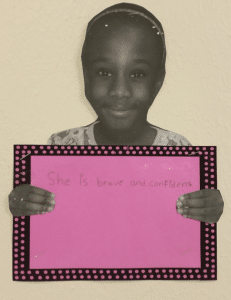
What’s your sentence? What is one sentence that would convey what you are all about?
I loved this idea when I saw it in this video:
It’s part of Dan Pink‘s work on motivation, which I love and speak about in my trainings on internal motivation.
I started incorporating “What’s your sentence?” into a professional development experience I facilitate.
The idea is that students can create sentences that reflect their future goals and desires for how people will view them.
I got an email from a teacher in Grand Prairie, Texas, who attended the session and used it with her students. With her permission, I share some of their sentences.





Aren’t they amazing?
It makes you believe in the world again, doesn’t it?
So a huge shout out to Kayla Ferrell of the Grand Prairie ISD who took her professional development experience and make it relevant to her students. Love it.
How about you? What’s your sentence?
Is this something you could do with students or your family?
Looking for inspiration? Here’s a high school class sharing their sentences.
My sentence is, “She was a teacher, even when she didn’t have a classroom.”
I created a printable format for this activity that you can download free here.
Using What’s Your Sentence? to Introduce the Depth and Complexity Prompt of 🌳Big Idea
When introducing the thinking prompts to students, it’s helpful to have several activities for the same prompt. This ensures that students who didn’t fully understand it the first time have an opportunity for a second exposure. It’s also helpful if students were absent that day or if it’s been awhile since the prompt was used.
What’s Your Sentence? is a perfect activity to revisit the Depth and Complexity Thinking Prompt of 🌳Big Idea because your sentence is your very own 🌳Big Idea!
With a couple of simple tweaks, you can have a ready-to-use activity to reinforce or introduce this thinking prompt.
Remember that 🌳Big Idea is when we capture the meaning and importance of a thing or body of knowledge. It’s the “So what?” of our learning.
🌳Big Idea asks, “Now that we’ve studied this, what can we say about it? How can we capture its essence and importance? Its value? Its purpose? Its meaning on a broad scale?”
🌳Big Idea is never just a topic, which is why “What’s Your Sentence?” is a perfect activity for sharing this prompt. The topic is the student him/herself, but the sentence is their 🌳Big Idea. Pointing that out can help students distinguish between a topic and a 🌳Big Idea.
A topic is a title or a name. A 🌳Big Idea is what we can say about that thing because we have learned about it or know it.
Suggested Uses for 🌳Big Idea and “What’s Your Sentence?”
If you would like to use “What’s Your Sentence?” to introduce the 🌳Big Idea thinking prompt, here’s what I’d suggest.
I’d go in backwards.
I’d start with the “What’s Your Sentence?” activity and then move from there to 🌳Big Idea. After they have their sentence (and have shared them in a gallery walk or in front of the class), use the following ideas to connect the activity to 🌳Big Idea.
- When you wrote your sentence, you were trying to capture the most important thing about yourself – the thing that if someone wanted to know you, they would definitely want to know that. In Depth and Complexity, the thinking prompt that lets us do that with our learning is called 🌳Big Idea.
- The 🌳Big Idea is what we can say about something because we know it or have learned about it. For instance, after we learn the alphabet, we could say that the 🌳Big Idea of the alphabet is that it is the foundation of all written communication. Without the alphabet we couldn’t read or write, and our ability to communicate with each other would be very limited.
- When we talk about the 🌳Big Idea, we focus on why it’s important, not just saying a definition of the thing. We don’t just say, “Oh, the alphabet is a set of 26 letters that combine to make words.” We say, “The alphabet allows us to communicate in a way that is a large part of what it means to be human in a community.”
- When we are looking at our learning, we can think of the 🌳Big Idea as the “What’s your sentence?” of our learning. We think, “Hmmm, I’ve learned about this. What is its sentence?”
- [Give examples from recent learning such as… “Hey, living things (as opposed to non-living things), what’s your sentence?” or “Hey, vowels, what’s your sentence?” and let students come up with sample sentences. Identify these as a 🌳Big Idea of that thing.]
- We can even compare the 🌳Big Idea or sentence of one thing to the 🌳Big Idea or sentence of another thing. How is the 🌳Big Idea or sentence of the alphabet similar to the 🌳Big Idea of numbers? How are they different? What else has a similar 🌳Big Idea?



